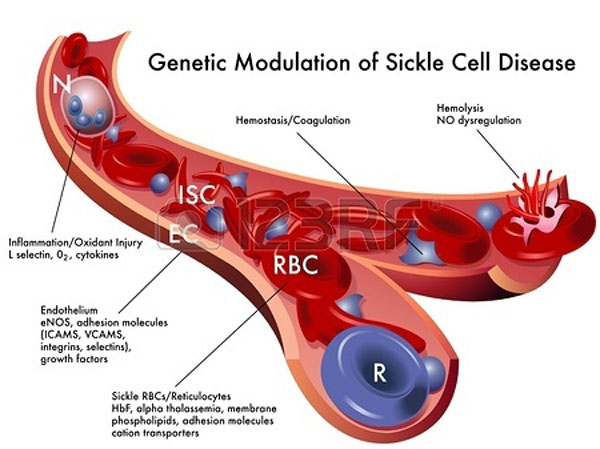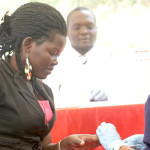
Clad in a nicely fitting knee-length hot-red skirt suit with her hair neatly plaited in black bob braids, Ruth Nankanja is the embodiment of true corporate elegance. With each word spoken, Nankanja exudes a confidence and eloquence that leaves many in awe of her.
One look at her is enough to convince you that she has lived a very lucky life. Her reality, however, is painfully different.
Diagnosed with Sickle Cell Disease (SCD) at a very tender age, Nankanja had to battle with stigmatization from teachers and her fellow peers.
“Back in primary school, my parents gave me a medical letter indicating that I had sickle cell to deliver to my teacher. That day, as my classmates went for the physical education (PE) class, I was restricted from attending this class by the teacher who loudly commented that I had sickle cell disease,” Nankanja narrates.
From that day forth, Nankanja was restricted from engaging in any fun activities in school because of her health condition. At a very tender age, she was subjected to stigmatization in all its painful forms.
“When I joined secondary, my parents gave me the same letter to give to my teachers. For fear of being stigmatized again, I chewed it up. I went through the whole of my secondary school without telling anyone about my health condition,” she narrates.
Nankanja held life by the horns and battled her way through stigmatization, pain and suffering. Married for 12 years now, she has two children: a 10 year-old and two year-old.
Nankanja is currently the Chief Executive Officer (CEO) of Sickle Cell Association Uganda (SAU) and has dedicated her life to fighting and creating awareness about sickle cell disease. She is one of the lucky few survivors with the disease.
Studies
According to studies conducted in the 1960s, 80 per cent of the estimated 20,000 babies born with SCD annually in Uganda died before they celebrated their fifth birth day.
However, new studies reveal that;
- 25 per cent of infants between birth and 18 months of age die because of SCD;
- Sickle cell disease affects 7 out of every 150 children in Uganda, and;
- 13 out of every 100 children have sickle cell trait.
The Uganda sickle cell surveillance study, carried out on over 90,000 children, also revealed that rates of sickle cell disease are lower in HIV positive infants.
Of the 112 districts subjected to the study, 14 districts contain 47 per cent of the sickle cell disease;
These districts are: Kampala, Gulu, Lira, Jinja, Tororo, Luweero, Wakiso, Apac, Iganga, Mayuge, Buikwe, Oyam, Masaka and Masindi, and;
Highest rates of sickle cell disease were noted in the North and Central regions of Uganda;
Eight of the 112 districts have 20 per cent of the sickle cell trait. These districts are: Bundibugyo, Busia, Alebtong, Jinja, Tororo, Gulu and Lira.
This study was released last Thursday by the Ministry of Health in partnership with the Division of Hematology and Global Health Center Cincinnati Children’s Hospital USA, Department of Pediatric and Child Health Makerere University College of Health Sciences and Central Public Health Laboratories (CPHL).
According to the principal researcher from the Department of Pediatric and Child Health, Professor Grace Ndeezi, blood samples were collected from different health centres, thereafter taken to the district hub, then to the regional hub and later transported to the central laboratories where they were tested.
The disease
Sickle Cell Disease (SCD) is a genetic disorder in which the body creates sickle-shaped red blood cells, which affect blood flow in cells and organs. This causes pain, organ damage and raises the risk of infection.
SCD is genetic, and is neither contagious nor a punishment or family curse as some Ugandans might believe. Sickle Cell trait, on the other hand, is not the same as the disease and can’t change into the disease.
SCD is a lifelong incurable disease, though treatments are available to alleviate the pain and prolong one’s life.
According to the study, sickle-cell anaemia, the commonest type of SCD in Uganda, remains high where malaria is endemic.
SCD screening campaign
This presentation of findings was followed by the launch of the nation-wide Sickle Cell screening campaign that kicked off with free screening at the University’s freedom square. From primary schools to secondary and university schools, the freedom square was bursting with people from all walks of life.
One Ruth Nakayiza brought her 14year old son to be screened for free. “My son has been feeling severe joint pains for a long time now. I had him tested for typhoid, brucella and malaria but the tests were nagative,” she says in Luganda.
“I was later advised to have him tested for sickle cell at a fee of Shs30, 000. However, when I heard that there would be free screening at Makerere University, I decided to bring him along,” Nakayiza says.
Speaking at the launch of the nationwide screening campaign, state minister for Primary Health Care, Sarah Achieng Opendi expressed her enthusiasm that the survey’s finding would help inform proper planning and look for resources to fight against SCD.
“We cannot plan and allocate resources without data. These results have availed us with enough data to come up with a Sickle Cell control strategy,” Opendi said.
The national sickle cell screening campaign will be taken to other parts of the country with high prevalence rates.







